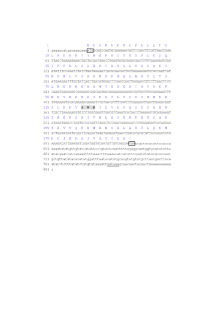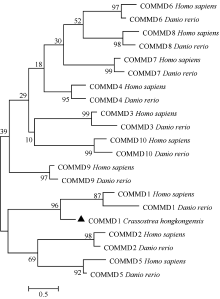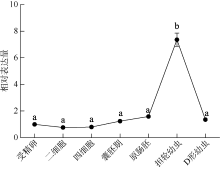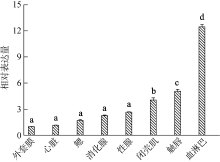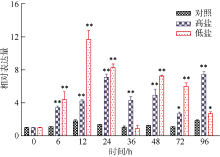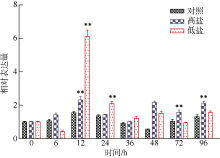| [1] |
贺洪军, 戴爱国, 符代炎, 2011. 多功能蛋白质COMMD1[J]. 中国生物化学与分子生物学报, 27(12): 1113-1118.
|
|
HE HONGJUN, DAI AIGUO, FU DAIYAN, 2011. Multifunctional protein COMMD1[J]. Chinese Journal of Biochemistry and Molecular Biology, 27(12): 1113-1118 (in Chinese with English abstract).
|
| [2] |
李佩佩, 2009. 青岛文昌鱼COMMD6基因的克隆、表达和功能分析[D]. 青岛: 中国海洋大学.
|
|
LI PEIPEI, 2009. Cloning, expression and functional analysis of COMMD6 gene in amphioxus Branchiostoma belcheri tsingtauense[D]. Qingdao: Ocean University of China (in Chinese with English abstract).
|
| [3] |
肖莞生, 陈子燊, 2010. 珠江河口区枯季咸潮入侵与盐度输运机理分析[J]. 水文, 30(3): 10-14, 21.
|
|
XIAO GUANSHENG, CHEN ZISHEN, 2010. Analysis of saline intrusion and salinity transport mechanism in estuary of Pearl River[J]. Journal of China Hydrology, 30(3): 10-14, 21 (in Chinese with English abstract).
|
| [4] |
BERGER V J, KHARAZOVA A D, 1997. Mechanisms of salinity adaptations in marine molluscs[M]//NAUMOV A D, HUMMEL H, SUKHOTIN A A, et al. Interactions and Adaptation Strategies of Marine Organisms. St. Petersburg, Russia: Springer: 115-126.
|
| [5] |
BURSTEIN E, GANESH L, DICK R D, et al, 2004. A novel role for XIAP in copper homeostasis through regulation of MURR1[J]. The EMBO Journal, 23(1): 244-254.
|
| [6] |
BURSTEIN E, HOBERG J E, WILKINSON A S, et al, 2005. COMMD proteins, a novel family of structural and functional homologs of MURR1[J]. Journal of Biological Chemistry, 280(23): 22222-22232.
|
| [7] |
DE BIE P, VAN DE SLUIS B, KLOMP L, et al, 2005. The many faces of the copper metabolism protein MURR1/COMMD1[J]. Journal of Heredity, 96(7): 803-811.
|
| [8] |
DRÉVILLON L, TANGUY G, HINZPETER A, et al, 2011. COMMD1- mediated ubiquitination regulates CFTR trafficking[J]. PLoS One, 6(3): e18334.
|
| [9] |
JIN PENG, GAO YINGQIU, CHEN LIMING, et al, 2012. Cloning and characterization of a COMMD4 gene from amphioxus (Branchiostoma belcheri): an insight into the function and evolution of COMMD4[J]. Immunology Letters, 148(2): 110-116.
|
| [10] |
KE Y, BUTT A G, SWART M, et al, 2010. COMMD1 downregulates the epithelial sodium channel through Nedd4-2[J]. American Journal of Physiology-Renal Physiology, 298(6): F1445-F1456.
|
| [11] |
KLOMP A E M, VAN DE SLUIS B, KLOMP L W J, et al, 2003. The ubiquitously expressed MURR1 protein is absent in canine copper toxicosis[J]. Journal of Hepatology, 39(5): 703-709.
|
| [12] |
LI PEIPEI, ZHANG SHICUI, FAN CHUNXIN, 2009. COMMD6 from amphioxus Branchiostoma belcheri (BbCOMMD6) interacts with creatine kinase and inhibits its activity[J]. The International Journal of Biochemistry & Cell Biology, 41(12): 2459-2465.
|
| [13] |
MAINE G N, BURSTEIN E, 2007. COMMD proteins: COMMing to the scene[J]. Cellular and Molecular Life Sciences, 64(15): 1997-2005.
|
| [14] |
MATERIA S, CATER M A, KLOMP L W J, et al, 2012. Clusterin and COMMD1 independently regulate degradation of the mammalian copper ATPases ATP7A and ATP7B[J]. Journal of Biological Chemistry, 287(4): 2485-2499.
|
| [15] |
MENG JIE, ZHU QIHUI, ZHANG LINLIN, et al, 2013. Genome and transcriptome analyses provide insight into the euryhaline adaptation mechanism of Crassostrea gigas[J]. PLoS One, 8(3): e58563.
|
| [16] |
NABETANI A, HATADA I, MORISAKI H, et al, 1997. Mouse U2af1-rs1 is a neomorphic imprinted gene[J]. Molecular and Cellular Biology, 17(2): 789-798.
|
| [17] |
PIERCE S K, AMENDE L M, 1981. Control mechanisms of amino acid-mediated cell volume regulation in salinity-stressed molluscs[J]. Journal of Experimental Zoology, 215(3): 247-257.
|
| [18] |
QU FUFA, XIANG ZHIMING, WANG FUXUAN, et al, 2015. A novel molluscan Fos gene with immune defense function identified in the Hong Kong oyster, Crassostrea hongkongensis[J]. Developmental & Comparative Immunology, 51(1): 194-201.
|
| [19] |
SMITH L, LITMAN P, LIEDTKE C M, 2013. COMMD1 interacts with the COOH terminus of NKCC1 in Calu-3 airway epithelial cells to modulate NKCC1 ubiquitination[J]. American Journal of Physiology-Cell Physiology, 305(2): C133-C146.
|
| [20] |
SOMMERHALTER M, ZHANG YONGBO, ROSENZWEIG A C, 2007. Solution structure of the COMMD1 N-terminal domain[J]. Journal of Molecular Biology, 365(3): 715-721.
|
| [21] |
TIRARD C T, GROSSFELD R M, LEVINE J F, et al, 1997. Effect of osmotic shock on protein synthesis of oyster hemocytes in vitro[J]. Comparative Biochemistry and Physiology Part A: Physiology, 116(1): 43-49.
|
| [22] |
VAN DE SLUIS B, GROOT A J, WIJMENGA C, et al, 2007. COMMD1: A novel protein involved in the proteolysis of proteins[J]. Cell Cycle, 6(17): 2091-2098.
|
| [23] |
VAN DE SLUIS B, ROTHUIZEN J, PEARSON P L, et al, 2002. Identification of a new copper metabolism gene by positional cloning in a purebred dog population[J]. Human Molecular Genetics, 11(2): 165-173.
|
| [24] |
XIANG ZHIMING, QU FUFA, WANG FUXUAN, et al, 2015. ChBax/Bak as key regulators of the mitochondrial apoptotic pathway: cloned and characterized in Crassostrea hongkongensis[J]. Fish & Shellfish Immunology, 42(2): 225-232.
|
| [25] |
YANG MEI, XU FEI, LIU JUN, et al, 2014. Phylogeny of forkhead genes in three spiralians and their expression in Pacific oyster Crassostrea gigas[J]. Chinese Journal of Oceanology and Limnology, 32(6): 1207-1223.
|
 ), Shu XIAO1, Zhiming XIANG1(
), Shu XIAO1, Zhiming XIANG1( ), Ziniu YU1(
), Ziniu YU1( )
)


